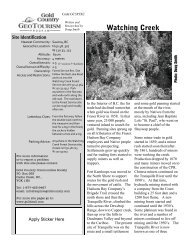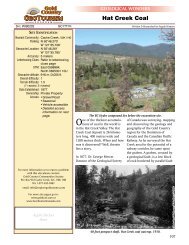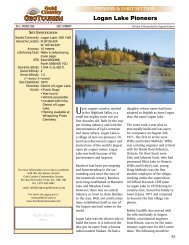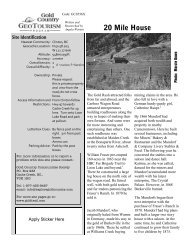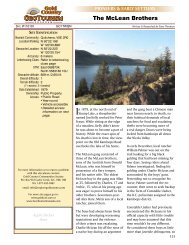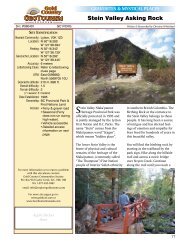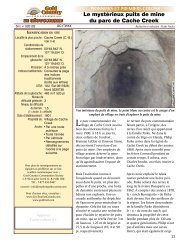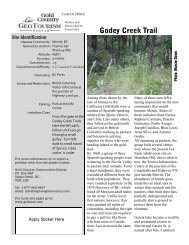E book Field Guide.indd - Gold Country
E book Field Guide.indd - Gold Country
E book Field Guide.indd - Gold Country
Create successful ePaper yourself
Turn your PDF publications into a flip-book with our unique Google optimized e-Paper software.
View of Savona and Kamloops Lake<br />
Photo: Kamloops Museum & Archives, n o 7699<br />
ferry, on which we crossed the horses, while the cattle swam.<br />
Another day found us on the Bonaparte, near the mouth of<br />
Cash Creek.”<br />
It was noted in the Christmas 1862 Victoria Colonist<br />
that François Saveneux had passed away. With her<br />
daughter’s help Mrs. Saveneux continued to run the<br />
enterprise. The H.B.C. sent Donald McLean, son of the<br />
Chief Trader, to help with their end of the business.<br />
In 1866 Ned Roberts was the operator; however by<br />
1870 the provincial government had taken over the<br />
ferry and appointed James Uren.<br />
Bourke, a one-time Hudson Bay Company employee.<br />
Bourke’s daughter, Frances, brought her teenage daughter<br />
with her to Savona.<br />
The early ferry was only large enough for saddle horse<br />
and pedestrian traffic, as there was only a trail west<br />
of Savona. The Royal Engineers did not complete the<br />
Wagon Road from Cache Creek until 1866. With the<br />
road completion and wagon traffic, a vessel larger than<br />
a raft became required.<br />
A traveler who recorded his crossing at Savona was 16<br />
year old Andrew Jackson Splawn. A.J. had been hired by<br />
Major John Thorpe to help drive a herd of cattle to the<br />
gold fields. They arrived at the ferry in the late fall of<br />
1861.<br />
“We crossed the Thompson River at the old landmark kept<br />
by Savanos, a French Canadian, who had come to New<br />
Caledonia-the name given to all of British Columbia- with the<br />
Hudson’s Bay Company at a very early date. He had a small<br />
Accidents were commonplace, the high water flood of<br />
June 1875 broke the cable and the ferry was down until<br />
the following year. In 1878 the scow broke away again<br />
and in 1879 there was another break, resulting in the<br />
drowning of Charles Fortier, a retired H.B.C. employee.<br />
Continued requests were made for the construction<br />
of a bridge to replace the ferry but it was not until the<br />
Canadian Pacific Railway arrived in Savona in 1883 that<br />
construction started. It was completed in 1884 at a cost<br />
of $15,250.00.<br />
The bridge also had its problems. In 1888, it was<br />
covered by the high water; in 1894 it was swept away<br />
by the flood. This brought the ferry back into operation<br />
until 1906.<br />
The site of the original ferry can be seen on the North<br />
side of the present day bridge.<br />
BIBLIOGRAPHY & SOURCES<br />
Balf, M. (1980). Savona’s Ferry. In Kamloops Museum and Archives.<br />
Splawn, A.J. (1917). Ka-ma-akin-The Last Hero of the Yakimas.<br />
118






